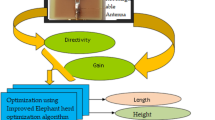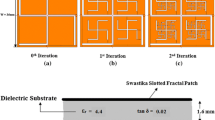Abstract
The paper proposes optimization of square split-ring resonator (SRR) metamaterial unit cell using modified hybrid bacterial foraging–particle swarm optimization (BF-PSO). Optimized metamaterial unit cells are loaded into novel designed square fractal antenna for its bandwidth enhancement. The presented research is alienated in three phases: Novel design of microstrip line-fed square fractal antenna with defected ground structure is proposed in the initial phase that provides dual band performance. In second phase, with the aim of bandwidth enhancement, quasi-static model of SRR unit cell is used to optimize its structural parameters so that optimized structure resonates at desired frequency region. Modifications are included in hybrid BF-PSO algorithm as per size constraints of SRR unit cell to be optimized and for improving the convergence behavior of algorithm. The performance of modified hybrid BF-PSO algorithm is assessed against four other evolutionary techniques named as classical BFO, chaos PSO, IWO and ABC. In later phase, optimized SRR unit cells are loaded into initially designed square fractal antenna that results in broadband performance suitable for upper S-band and lower C-band wireless applications. The designed square fractal antenna without and with SRR unit cells is fabricated and tested to verify the experimental results.














Similar content being viewed by others
Explore related subjects
Discover the latest articles and news from researchers in related subjects, suggested using machine learning.References
Choukiker YK, Behera SK (2014) Modified Sierpinski square fractal antenna covering ultra-wide band application with band notch characteristics. IET Microwaves Antennas Propag 8:506–512. https://doi.org/10.1049/iet-map.2013.0235
Werner DH, Haupt RL, Werner PL (1999) Fractal antenna engineering: the theory and design of fractal antenna arrays. IEEE Antennas Propag Mag 41:37–59. https://doi.org/10.1109/74.801513
Werner DH, Ganguly S (2003) An overview of fractal antenna engineering research. IEEE Antennas Propag Mag 45:38–57. https://doi.org/10.1109/MAP.2003.1189650
Kim D-J, Choi J-H, Kim Y-S (2013) CPW-fed ultrawideband flower-shaped circular fractal antenna. Microw Opt Technol Lett 55:1792–1795. https://doi.org/10.1002/mop
Gianvittorio JP, Rahmat-Samii Y (2002) Fractal antennas: a novel antenna miniaturization technique, and applications. IEEE Antennas Propag Mag 44:20–36. https://doi.org/10.1109/74.997888
Kumar Y, Singh S (2015) A compact multiband hybrid fractal antenna for multistandard mobile wireless applications. Wirel Pers Commun 84:57–67. https://doi.org/10.1007/s11277-015-2593-x
Rani S, Singh AP (2014) On the design and analysis of modified koch curve fractal antenna. J Inst Eng Ser B 94:231–236. https://doi.org/10.1007/s40031-013-0061-0
Shafie SN, Adam I, Soh PJ (2010) Design and simulation of a modified minkowski fractal antenna for tri-band application. In: 4th international conference on mathematical/analytical modelling and computer simulation (AMS). IEEE, Kota Kinabalu, Malaysia, pp 567–570
Baliarda CP, Borau CB, Rodero MN, Robert JR (2000) An iterative model for fractal antennas: application to the Sierpinski gasket antenna. IEEE Trans Antennas Propag 48:713–719. https://doi.org/10.1109/8.855489
Kaur A, Saluja N, Ubhi JS (2012) Design Of Sierpinski gasket multiband fractal antenna for wireless applications. IOSR J Electron Commun Eng 2:5–6
Srivastava DK, Khanna A, Saini JP (2016) Design of a wideband gap-coupled modified square fractal antenna. J Comput Electron 15:239–247. https://doi.org/10.1007/s10825-015-0740-y
Dorostkar MA, Azim R, Islam MT (2013) A novel Γ-shape fractal antenna for wideband communications. Procedia Technol 11:1285–1291. https://doi.org/10.1016/j.protcy.2013.12.326
Sarkar T, Chakravorty J, Ghatak R (2015) Broadband fractal slot planar antenna. In: Third international conference on computer, communication, control and information technology (C3IT). IEEE, Hooghly, India, pp 3–7
Singh A, Singh S (2015) Design and optimization of a modified Sierpinski fractal antenna for broadband applications. Appl Soft Comput 38:843–850. https://doi.org/10.1016/j.asoc.2015.10.013
Kushwaha N, Kumar R (2013) An UWB fractal antenna with defected ground structure and swastika shape electromagnetic band gap. Prog Electromagn Res B 52:383–403. https://doi.org/10.2528/PIERB13051509
Bilotti F, Toscano A, Vegni L (2007) Design of spiral and multiple split-ring resonators for the realization of miniaturized metamaterial samples. IEEE Trans Antennas Propag 55:2258–2267. https://doi.org/10.1109/TAP.2007.901950
Zhi-ning C (2014) Metamaterials and metamaterial-based antenna technology. J Shanghai Univ Nat Sci 20:531–540. https://doi.org/10.3969/j.issn.1007-2861.2014.03.011
Veselago VG (1968) The electrodynamics of substances with simultaneously negative values of epsilon and μ. Sov Phys Uspekhi 10:509–514. https://doi.org/10.1070/PU1968v010n04ABEH003699
Pendry JB, Holden AJ, Robbins DJ, Stewart WJ (1999) Magnetism from conductors and enhanced nonlinear phenomena. IEEE Trans Microw Theory Tech 47:2075–2084. https://doi.org/10.1109/22.798002
Shelby RA, Smith DR, Nemat-Nasser SC, Schultz S (2001) Microwave transmission through a two-dimensional, isotropic, left-handed metamaterial. Appl Phys Lett 78:489–491. https://doi.org/10.1063/1.1343489
Ekmekci E, Topalli K, Akin T, Turhan-Sayan G (2009) A tunable multi-band metamaterial design using micro-split SRR structures. Opt Express 17:16046–16058. https://doi.org/10.1364/OE.17.016046
Rani MSA, Kamal S, Rahim A et al (2014) Electromagnetic behaviors of thin film CPW-fed CSRR loaded on UWB transparent antenna. IEEE Antennas Wirel Propag Lett 13:1239–1242. https://doi.org/10.1109/LAWP.2014.2332514
Sharma R, Singh H (2015) Left handed metamaterial antenna design for GSM 1.8 GHz applications. In: 2nd international conference on recent advances in engineering & computational sciences (RAECS). IEEE, Chandigarh, India, pp 1–5
Li D, Szabó Z, Qing X et al (2012) A high gain antenna with an optimized metamaterial inspired superstrate. IEEE Trans Antennas Propag 60:6018–6023. https://doi.org/10.1109/TAP.2012.2213231
Kennedy J, Eberhart R (1995) Particle swarm optimization. In: IEEE international conference on neural networks. IEEE, Perth, WA, Australia, pp 1942–1948
Passino KM (2002) Biomimicry of bacterial foraging for distributed optimization and control. IEEE Control Syst 22:52–67. https://doi.org/10.1109/MCS.2002.1004010
Mehrabian AR, Lucas C (2006) A novel numerical optimization algorithm inspired from weed colonization. Ecol Inform 1:355–366. https://doi.org/10.1016/j.ecoinf.2006.07.003
Karaboga D, Basturk B (2007) A powerful and efficient algorithm for numerical function optimization : artificial bee colony (ABC) algorithm. J Glob Optim 39:459–471. https://doi.org/10.1007/s10898-007-9149-x
Chen H, Zhu Y, Hu K (2011) Adaptive bacterial foraging optimization. Abstr Appl Anal Hindawi Publ Corp. https://doi.org/10.1155/2011/108269
Kim DH, Abraham A, Cho JH (2007) A hybrid genetic algorithm and bacterial foraging approach for global optimization. Inf Sci (NY) 177:3918–3937. https://doi.org/10.1016/j.ins.2007.04.002
Korani WM, Dorrah HT, Emara HM (2009) Bacterial foraging oriented by particle swarm optimization strategy for PID tuning. In: IEEE international symposium on computational intelligence in robotics and automation. IEEE, Daejeon, South Korea, pp 1–6
Rao RV, Saroj A (2017) A self-adaptive multi-population based jaya algorithm for engineering Optimization. Swarm Evol Comput 37:1–26. https://doi.org/10.1016/j.swevo.2017.04.008
Singh G, Gupta MK, Mia M, Sharma VS (2018) Modeling and optimization of tool wear in MQL-assisted milling of Inconel 718 superalloy using evolutionary techniques. Int J Adv Manuf Technol 97:481–494. https://doi.org/10.1007/s00170-018-1911-3
Prakash C, Singh S, Singh M et al (2018) Multi-objective parametric appraisal of pulsed current gas tungsten arc welding process by using hybrid optimization algorithms. Int J Adv Manuf Technol 101:1107–1123. https://doi.org/10.1007/s00170-018-3017-3
Dhaliwal BS, Pattnaik SS (2016) Performance comparison of bio-inspired optimization algorithms for Sierpinski gasket fractal antenna design. Neural Comput Appl 27:585–592. https://doi.org/10.1007/s00521-015-1879-y
Dhaliwal BS, Pattnaik SS (2016) BFO–ANN ensemble hybrid algorithm to design compact fractal antenna for rectenna system. Neural Comput Appl 28:917–928. https://doi.org/10.1007/s00521-016-2402-9
Singh U, Salgotra R (2016) Synthesis of linear antenna array using flower pollination algorithm. Neural Comput Appl. https://doi.org/10.1007/s00521-016-2457-7
Salgotra R, Singh U (2016) A novel bat flower pollination algorithm for synthesis of linear antenna arrays. Neural Comput Appl. https://doi.org/10.1007/s00521-016-2833-3
Babayigit B, Senyigit E (2017) Design optimization of circular antenna arrays using Taguchi method. Neural Comput Appl 28:1443–1452. https://doi.org/10.1007/s00521-015-2162-y
Choudhury B, Manickam S, Jha RM (2013) Particle Swarm Optimization for Multiband Metamaterial Fractal Antenna. J Optim Hindawi Publ Corp. https://doi.org/10.1155/2013/989135
Deshmukh AA, Phatak N, Nagarbowdi S (2014) Broadband proximity fed rectangular slot cut C-shaped microstrip antenna array. In: International conference on circuits, systems, communication and information technology applications (CSCITA). IEEE, Mumbai, India, pp 7–12
Baena JD, Bonache J, Martín F et al (2005) Equivalent-circuit models for split-ring resonators and complementary split-ring resonators coupled to planar transmission lines. IEEE Trans Microw Theory Tech 53:1451–1460. https://doi.org/10.1109/TMTT.2005.845211
Rajni Singh G, Marwaha A (2015) Modeling of split ring resonators loaded microstrip line with different orientations. Int J Electr Comput Eng 5:1363–1371
Bojanic R, Milosevic V, Jokanovic B et al (2014) Enhanced modelling of split-ring resonators couplings in printed circuits. IEEE Trans Microw Theory Tech 62:1605–1615. https://doi.org/10.1109/TMTT.2014.2332302
Gupta N, Saxena J, Bhatia KS (2017) Design optimization of CPW-fed microstrip patch antenna using constrained ABFO algorithm. Soft Comput. https://doi.org/10.1007/s00500-017-2775-4
Bansal JC, Singh PK, Saraswat M et al (2011) Inertia weight strategies in particle swarm optimization. In: Third world congress on nature and biologically inspired computing (NaBIC). IEEE, pp 640–647
Feng Y, Teng G, Wang A, Yao Y (2007) Chaotic inertia weight in particle swarm optimization. In: Second international conference on innovative computing, information and control (ICICIC’07). IEEE, Kumamoto, Japan, pp 7–10
Bilotti F, Toscano A, Vegni L et al (2007) Equivalent-circuit models for the design of metamaterials based on artificial magnetic inclusions. IEEE Trans Microw Theory Tech 55:2865–2873. https://doi.org/10.1109/TMTT.2007.909611
Numan AB, Sharawi MS (2013) Extraction of material parameters for metamaterials using a full-wave simulator. IEEE Antennas Propag Mag 55:202–211. https://doi.org/10.1109/MAP.2013.6735515
Mia M, Khan A, Dhar NR (2017) Performance prediction of high-pressure coolant assisted turning of Ti–6Al–4V. Int J Adv Manuf Technol 90:1433–1445. https://doi.org/10.1007/s00170-016-9468-5
Mia M, Ranjan N (2017) Prediction and optimization by using SVR, RSM and GA in hard turning of tempered AISI 1060 steel under effective cooling condition. Neural Comput Appl. https://doi.org/10.1007/s00521-017-3192-4
Author information
Authors and Affiliations
Corresponding author
Ethics declarations
Conflict of interest
The authors declare that they have no conflict of interest.
Ethical approval
This article does not contain any studies with human participants or animals performed by any of the authors.
Additional information
Publisher's Note
Springer Nature remains neutral with regard to jurisdictional claims in published maps and institutional affiliations.
Rights and permissions
About this article
Cite this article
Gupta, N., Saxena, J. & Bhatia, K.S. Optimized metamaterial-loaded fractal antenna using modified hybrid BF-PSO algorithm. Neural Comput & Applic 32, 7153–7169 (2020). https://doi.org/10.1007/s00521-019-04202-z
Received:
Accepted:
Published:
Issue Date:
DOI: https://doi.org/10.1007/s00521-019-04202-z




